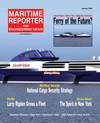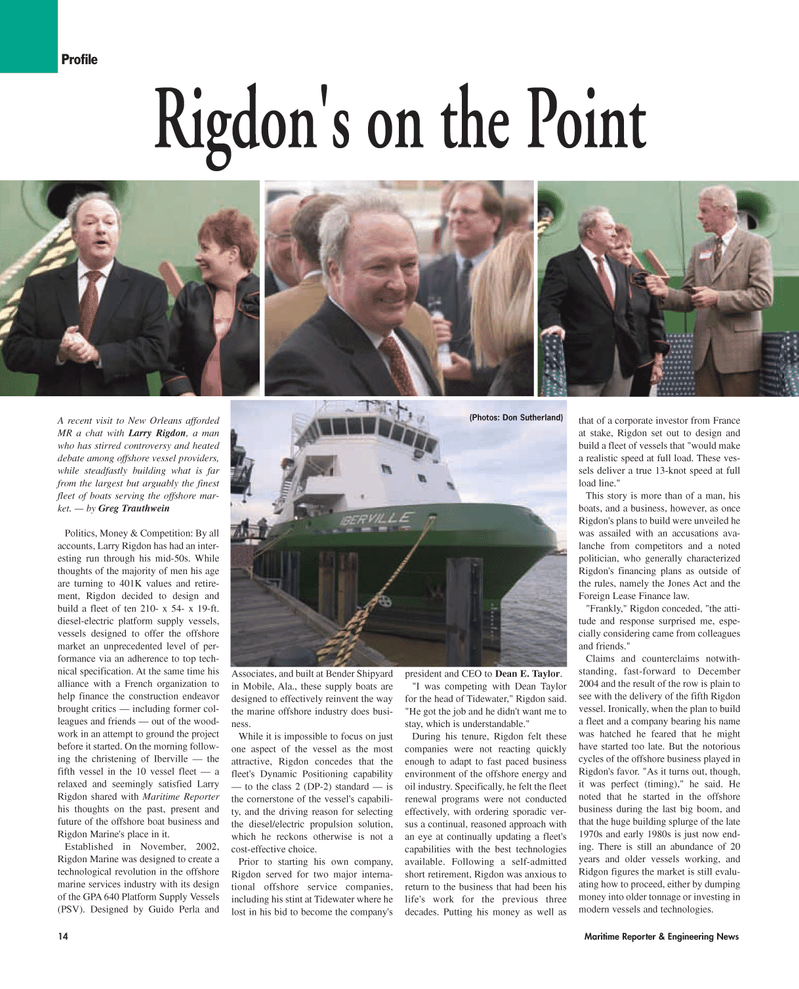
Page 14: of Maritime Reporter Magazine (January 2, 2005)
Read this page in Pdf, Flash or Html5 edition of January 2, 2005 Maritime Reporter Magazine
A recent visit to New Orleans afforded
MR a chat with Larry Rigdon, a man who has stirred controversy and heated debate among offshore vessel providers, while steadfastly building what is far from the largest but arguably the finest fleet of boats serving the offshore mar- ket. — by Greg Trauthwein
Politics, Money & Competition: By all accounts, Larry Rigdon has had an inter- esting run through his mid-50s. While thoughts of the majority of men his age are turning to 401K values and retire- ment, Rigdon decided to design and build a fleet of ten 210- x 54- x 19-ft. diesel-electric platform supply vessels, vessels designed to offer the offshore market an unprecedented level of per- formance via an adherence to top tech- nical specification. At the same time his alliance with a French organization to help finance the construction endeavor brought critics — including former col- leagues and friends — out of the wood- work in an attempt to ground the project before it started. On the morning follow- ing the christening of Iberville — the fifth vessel in the 10 vessel fleet — a relaxed and seemingly satisfied Larry
Rigdon shared with Maritime Reporter his thoughts on the past, present and future of the offshore boat business and
Rigdon Marine's place in it.
Established in November, 2002,
Rigdon Marine was designed to create a technological revolution in the offshore marine services industry with its design of the GPA 640 Platform Supply Vessels (PSV). Designed by Guido Perla and
Associates, and built at Bender Shipyard in Mobile, Ala., these supply boats are designed to effectively reinvent the way the marine offshore industry does busi- ness.
While it is impossible to focus on just one aspect of the vessel as the most attractive, Rigdon concedes that the fleet's Dynamic Positioning capability — to the class 2 (DP-2) standard — is the cornerstone of the vessel's capabili- ty, and the driving reason for selecting the diesel/electric propulsion solution, which he reckons otherwise is not a cost-effective choice.
Prior to starting his own company,
Rigdon served for two major interna- tional offshore service companies, including his stint at Tidewater where he lost in his bid to become the company's president and CEO to Dean E. Taylor. "I was competing with Dean Taylor for the head of Tidewater," Rigdon said. "He got the job and he didn't want me to stay, which is understandable."
During his tenure, Rigdon felt these companies were not reacting quickly enough to adapt to fast paced business environment of the offshore energy and oil industry. Specifically, he felt the fleet renewal programs were not conducted effectively, with ordering sporadic ver- sus a continual, reasoned approach with an eye at continually updating a fleet's capabilities with the best technologies available. Following a self-admitted short retirement, Rigdon was anxious to return to the business that had been his life's work for the previous three decades. Putting his money as well as that of a corporate investor from France at stake, Rigdon set out to design and build a fleet of vessels that "would make a realistic speed at full load. These ves- sels deliver a true 13-knot speed at full load line."
This story is more than of a man, his boats, and a business, however, as once
Rigdon's plans to build were unveiled he was assailed with an accusations ava- lanche from competitors and a noted politician, who generally characterized
Rigdon's financing plans as outside of the rules, namely the Jones Act and the
Foreign Lease Finance law. "Frankly," Rigdon conceded, "the atti- tude and response surprised me, espe- cially considering came from colleagues and friends."
Claims and counterclaims notwith- standing, fast-forward to December 2004 and the result of the row is plain to see with the delivery of the fifth Rigdon vessel. Ironically, when the plan to build a fleet and a company bearing his name was hatched he feared that he might have started too late. But the notorious cycles of the offshore business played in
Rigdon's favor. "As it turns out, though, it was perfect (timing)," he said. He noted that he started in the offshore business during the last big boom, and that the huge building splurge of the late 1970s and early 1980s is just now end- ing. There is still an abundance of 20 years and older vessels working, and
Ridgon figures the market is still evalu- ating how to proceed, either by dumping money into older tonnage or investing in modern vessels and technologies. 14 Maritime Reporter & Engineering News
Profile
Rigdon's on the Point (Photos: Don Sutherland)
MR JANUARY 2005 #2 (9-16).qxd 1/5/2005 2:39 PM Page 6

 13
13

 15
15
